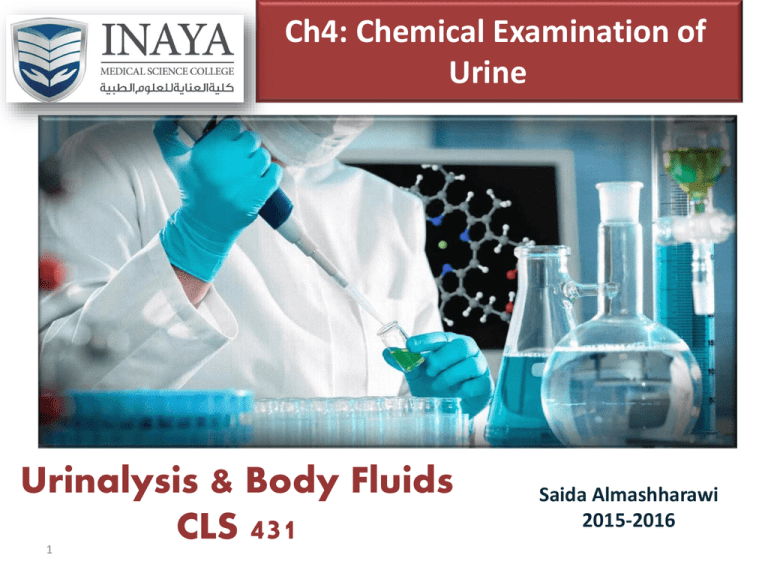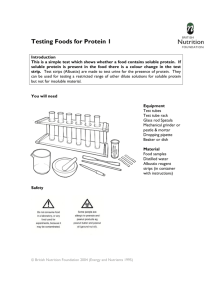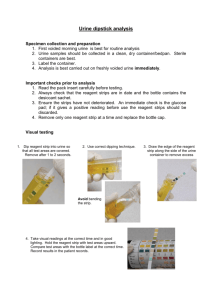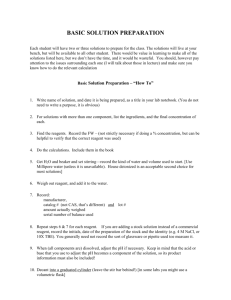Reagent Strip - INAYA Medical College
advertisement

Ch4: Chemical Examination of Urine Urinalysis & Body Fluids CLS 431 1 Saida Almashharawi 2015-2016 Learning Objectives Upon completing this chapter, the students will be able to: 1-Describe the proper technique for performing reagent strip testing. 2- List four causes of premature deterioration of reagent strips, and describe how to avoid them. 3 -List five quality-control procedures routinely performed with reagent strip testing. 4- List the reasons for measuring urinary pH, and discuss their clinical applications. 5- Discuss the principle of pH testing by reagent strip. 6-Differentiate between prerenal, renal, and postrenal proteinuria, and give clinical examples of each. 7-Explain the “protein error of indicators,” and list any sources of interference that may occur with this method of protein testing. 8 -Discuss microalbuminuria including significance, reagent strip tests, and their principles. 9 -Explain why glucose that is normally reabsorbed in the proximal convoluted tubule may appear in the urine, and state the renal threshold levels for glucose. 10- Name the three “ketone bodies” appearing in urine and three causes of ketonuria. 2 Learning Objectives 11- Differentiate between hematuria, hemoglobinuria, and myoglobinuria with regard to the appearance of urine and serum and clinical significance. 12- List some possible causes of a false-negative result in the reagent strip test for nitrite. 13- Discuss the advantages and sources of error of the reagent strip test for leukocytes. 14- Correlate physical and chemical urinalysis results 3 Reagent Strips It provide a simple, rapid means for performing medically significant chemical analysis of urine, including pH, protein, glucose, ketones, blood, bilirubin, urobilinogen, nitrite, leukocytes, and specific gravity. Two major types of reagent strips are manufactured under the trade names: - Multistix (Siemens Healthcare Diagnostics, Deerfield, IN) - Chemstrip (Roche Diagnostics, Indianapolis, IN). 4 Multistix Chemstrip Reagent Strips Reagent strips consist of chemical-impregnated absorbent pads attached to a plastic strip. A color-producing chemical reaction takes place when the absorbent pad comes in contact with urine. The reactions are interpreted by comparing the color produced on the pad within the required time frame with a chart supplied by the manufacturer. 5 Reagent Strips By careful comparison of the colors on the chart and the strip, a semiquantitative value of : trace, 1+, 2+, 3+, or 4+ can be reported. An estimate of the milligrams per deciliter present is available for appropriate testing areas. Automated reagent strip readers also provide Système International units. 6 Reagent Strips Chemstrip Multistix 7 Automated reagent strip reader Reagent Strips 8 Reagent Strips 9 Reagent Strips Errors Caused by Improper Technique 10 Handling and Storing Reagent Strips - Reagent strips are packaged in opaque containers with a desiccant to protect them from light and moisture. - Strips are removed just prior to testing, and the bottle is tightly resealed immediately. - Bottles should not be opened in the presence of volatile fumes. - Manufacturers recommend that reagent strips be stored at room temperature below 30°C (but never refrigerated). . 11 Handling and Storing Reagent Strips (cont.) - All bottles are stamped with an expiration date that represents the functional life expectancy of the chemical pads. Reagent strips must not be used past the expiration date. Care must be taken not to touch the chemical pads when removing the strips. A visual inspection of the strip should be done each time a strip is used to detect deterioration, even though the strips may still be within the expiration date. 12 Care of Reagent Strips 13 Technique of Reagent Strips 14 Quality Control of Reagent Strips 15 Quality Control of Reagent Strips (cont.) Reagent strips must be checked with both positive and negative controls a minimum of once every 24 hours. Many laboratories perform this check at the beginning of each shift. Testing is also performed when: - a new bottle of reagent strips is opened - questionable results are obtained, - or there is concern about the integrity of the strips. 16 Quality Control of Reagent Strips All quality control results must be recorded following laboratory protocol. Distilled water is not recommended as a negative control because reagent strip chemical reactions are designed to perform at ionic concentrations similar to urine. 17 Notes - Results that do not agree with the published values must be resolved through the testing of additional strips and controls. - Interfering substances in the urine, technical carelessness, and color blindness also produce errors. - Example; reagent strip interference is the masking of color reactions by - 18 the orange pigment present in the urine of persons taking phenazopyridine compounds. If laboratory personnel do not recognize the presence of this pigment or other pigments, they will report many erroneous results. Confirmatory Testing Confirmatory tests: are defined as test using different reagents or methodologies to detect the same substances as detected by the reagent strips with the same or greater sensitivity or Specificity. Increased specificity and sensitivity of reagent strips and the use of automated strip readers have reduced the need for routine use of these procedures. 19 pH - Along with the lungs, the kidneys are the major regulators of the acid– base content in the body. - a first morning specimen with a slightly acidic pH of 5.0 to 6.0; a more alkaline pH is found following meals. The pH of normal random samples can range from 4.5 to 8.0 20 pH It must be considered in conjunction with other patient information, such as - 21 the acid–base content of the blood, the patient’s renal function, the presence of a urinary tract infection, the patient’s dietary intake, and the age of the specimen. 22 Emphysema -a condition in which the air sacs of the lungs are damaged and enlarged, causing breathlessness. 23 pH- Clinical Significance The importance of urinary pH is primarily as an aid in determining the existence of systemic acid–base disorders of metabolic or respiratory origin and in the management of urinary conditions that require the urine to be maintained at a specific pH. 24 pH- Clinical Significance In respiratory or metabolic acidosis not related to renal function disorders, the urine is acidic; conversely, if respiratory or metabolic alkalosis is present, the urine is alkaline. 25 pH- Clinical Significance The precipitation of inorganic chemicals dissolved in the urine forms urinary crystals and renal calculi. This precipitation depends on urinary pH and can be controlled by maintaining the urine at a pH that is incompatible with the precipitation of the particular chemicals causing the calculi formation. e.g. calcium oxalate, precipitates primarily in acidic and not alkaline urine. Knowledge of urinary pH is important in the identification of crystals observed during microscopic examination of the urine sediment Maintaining an acidic urine can be valuable in treating urinary tract infections caused by urea-splitting organisms because they do not multiply as readily in an acidic medium. 26 pH- Clinical Significance Knowledge of urinary pH is important in the identification of crystals observed during microscopic examination of the urine sediment Maintaining an acidic urine can be valuable in treating urinary tract infections caused by urea-splitting organisms because they do not multiply as readily in an acidic medium. 27 pH- Clinical Significance Urinary pH is controlled primarily by dietary regulation, although medications also may be used. Persons on high-protein and high-meat diets tend to produce acidic urine, whereas urine from vegetarians is more alkaline, due to the formation of bicarbonate following digestion of many fruits and vegetables. 28 pH- Clinical Significance The pH of freshly excreted urine does not reach above 8.5 in normal or abnormal conditions. A pH above 8.5 is associated with an improperly preserved specimen and indicates that a fresh specimen should be obtained to ensure the validity of the analysis. 29 pH- Clinical Significance 30 pH- Reagent Strip Reactions - Measure urine pH between pH 5 and 9. - A double-indicator system of methyl red and bromthymol blue is used. Methyl red produces a color change from red to yellow in the pH range 4 to 6, and bromthymol blue turns from yellow to blue in the range of 6 to 9. 31 pH- Reagent Strip Reactions Therefore, in the pH range 5 to 9 measured by the reagent strips, one sees colors progressing from orange at pH 5 through yellow and green to a final deep blue at pH 9. No known substances interfere with urinary pH measurements performed by reagent strips. 32 Note: 33 pH- Reagent Strip 34 Protein Proteinuria is often associated with early renal disease, making the urinary protein test an important part of any physical examination. Normal urine contains very little protein: usually, less than 10 mg/dL or 100 mg per 24 hours is excreted. This protein consists primarily of low-molecular-weight serum protein 35 Protein Due to its low molecular weight, albumin is the major serum protein found in normal urine. Even though it is present in high concentrations in the plasma, the normal urinary albumin content is low because the majority of albumin presented to the glomerulus is not filtered, and much of the filtered albumin is reabsorbed by the tubules. 36 Protein Other proteins include small amounts of serum and tubular microglobulins; Tamm-Horsfall protein (uromodulin) produced by the renal tubular epithelial cells; and proteins from prostatic, seminal, and vaginal secretions. (Uromodulin is a more recent name for Tamm-Horsfall protein. Uromodulin is routinely produced in the distal convoluted tubule, & forms the matrix of casts formed in the distal convoluted tubule.) 37 Protein- Clinical Significance Demonstration of proteinuria in a routine analysis does not always signify renal disease; however, its presence does require additional testing to determine whether the protein represents a normal or a pathologic condition. Clinical proteinuria is indicated at 30 mg/dL or greater (300 mg/L). The causes of proteinuria can be grouped into three major categories [based on the origin of the protein]: - prerenal, - renal - postrenal, based on the origin of the protein. 38 Protein- Clinical Significance -Prerenal Proteinuria: - Prerenal Proteinuria: It is caused by conditions affecting the plasma prior to its reaching the kidney and, therefore, is not indicative of actual renal disease. - This condition is frequently transient, caused by increased levels of low-molecular-weight plasma proteins such as hemoglobin, myoglobin, and the acute phase reactants associated with infection and inflammation. 39 Protein- Clinical Significance -Prerenal Proteinuria: • The increased filtration of these proteins exceeds the normal reabsorptive capacity of the renal tubules, resulting in an overflow of the proteins into the urine. • Because reagent strips detect primarily albumin, prerenal proteinuria is usually not discovered in a routine urinalysis 40 Protein- Clinical Significance -Prerenal Proteinuria: Bence Jones Protein • Bence Jones Protein A primary example of proteinuria due to increased serum protein levels is the excretion of Bence Jones protein by persons with multiple myeloma. In multiple myeloma, a proliferative disorder of the immunoglobulinproducing plasma cells, the serum contains markedly elevated levels of monoclonal immunoglobulin light chains (Bence Jones protein). 41 Protein- Clinical Significance -Prerenal Proteinuria: Bence Jones Protein • This lowmolecular- weight protein is filtered in quantities exceeding the tubular reabsorption capacity and is excreted in the urine. Suspected cases of multiple myeloma must be diagnosed by performing serum electrophoresis and immunoelectrophoresis. The screening test for Bence Jones protein is not routinely performed 42 Protein- Clinical Significance -Prerenal Proteinuria: Bence Jones Protein 43 Protein- Clinical Significance -Renal Proteinuria: Proteinuria associated with true renal disease may be the result of either glomerular or tubular damage. - A- Glomerular Proteinuria: When the glomerular membrane is damaged, selective filtration is impaired, and increased amounts of serum protein and eventually red and white blood cells pass through the membrane and are excreted in the urine. Conditions that present the glomerular membrane with abnormal substances (e.g., amyloid material, toxic substances, and the immune complexes found in lupus erythematosus and streptococcal glomerulonephritis) are major causes of proteinuria due to glomerular damage. 44 Protein- Clinical Significance -Renal Proteinuria: A- Glomerular Proteinuria: (cont.) Increased pressure from the blood entering the glomerulus may override the selective filtration of the glomerulus, causing increased albumin to enter the filtrate. This condition may be reversible, such as occurs during strenuous exercise and dehydration or is associated with hypertension. 45 Protein- Clinical Significance -Renal Proteinuria: A- Glomerular Proteinuria: (cont.) Proteinuria that occurs during the latter months of pregnancy may indicate a pre-eclamptic state and should be considered by the physician in conjunction with other clinical symptoms, such as hypertension, to determine if this condition exists. 46 Protein- Clinical Significance -Renal Proteinuria: A- Glomerular Proteinuria: (cont.) The discovery of protein, particularly in a random sample, is not always of pathologic significance, because several benign causes of renal proteinuria exist. Benign proteinuria is usually transient and can be produced by conditions such as strenuous exercise, high fever, dehydration, and exposure to cold. 47 Protein- Clinical Significance -Renal Proteinuria: B- Microalbuminuria: • The development of diabetic nephropathy leading to reduced glomerular filtration and eventual renal failure is a common occurrence in persons with both type 1 and type 2 diabetes mellitus. Onset of renal complications can first be predicted by detection of microalbuminuria, and the progression of renal disease can be prevented through better stabilization of blood glucose levels and control of hypertension. The presence of microalbuminuria is also associated with an increased risk of cardiovascular disease 48 Protein- Clinical Significance -Renal Proteinuria: 49 Protein- Clinical Significance -Renal Proteinuria: • C- Orthostatic (Postural) Proteinuria A persistent benign proteinuria occurs frequently in young adults and is termed orthostatic proteinuria, or postural proteinuria. It occurs following periods spent in a vertical posture and disappears when a horizontal position is assumed. 50 Protein- Clinical Significance -Renal Proteinuria: • C- Orthostatic (Postural) Proteinuria Increased pressure on the renal vein when in the vertical position is believed to account for this condition. Patients suspected of orthostatic proteinuria are requested to empty the bladder before going to bed, collect a specimen immediately upon arising in the morning, and collect a second specimen after remaining in a vertical position for several hours. • 51 Both specimens are tested for protein, and if orthostatic proteinuria is present, a negative reading will be seen on the first morning specimen, and a positive result will be found on the second specimen. Protein- Clinical Significance -Renal Proteinuria: • D-Tubular Proteinuria Increased albumin is also present in disorders affecting tubular reabsorption because the normally filtered albumin can no longer be reabsorbed. Other low-molecular-weight proteins that are usually reabsorbed are also present. Causes of tubular dysfunction include exposure to toxic substances and heavy metals, severe viral infections, and Fanconi syndrome. The amount of protein that appears in the urine following glomerular damage ranges from slightly above normal to 4 g/day, whereas markedly elevated protein levels are seldom seen in tubular disorders. 52 Protein- Clinical Significance -Post Renal Proteinuria: Protein can be added to a urine specimen as it passes through the structures of the lower urinary tract (ureters, bladder, urethra, prostate, and vagina). Bacterial and fungal infections and inflammations produce exudates containing protein from the interstitial fluid. The presence of blood as the result of injury or menstrual contamination contributes protein, as does the presence of prostatic fluid and large amounts of spermatozoa. 53 54 ProteinReagent Strip Reactions - Indicators produce specific colors in response to particular pH levels. - certain indicators change color in the presence of protein even though the pH of the medium remains constant. This is because protein (primarily albumin) accepts hydrogen ions from the indicator. The test is more sensitive to albumin because albumin contains more amino groups to accept the hydrogen ions than other proteins. - the protein area of the strip contains either tetrabromophenol blue (Multistix) or 3',3",5',5"-tetrachlorophenol, 3,4,5,6-tetrabromosulfonphthalein (Chemstrip), and an acid buffer to maintain the pH at a constant level. 55 ProteinReagent Strip Reactions (cont.) At a pH level of 3, both indicators appear yellow in the absence of protein; however, as the protein concentration increases, the color progresses through various shades of green and finally to blue. Readings are reported in terms of negative, trace, 1+, 2+, 3+, and 4+; or the semi quantitative values of 30, 100, 300, or 2000 mg/dL corresponding to each color change. Trace values are considered to be less than 30 mg/dL. Interpretation of trace readings can be difficult. Reporting of trace values may be a laboratory option. 56 57 Protien- Reagent Strip Reactions Reaction Interference The major source of error with reagent strips - occurs with highly buffered alkaline urine that overrides the acid buffer system, producing a rise in pH and a color change unrelated to protein concentration. - see previous slide Note: Most laboratories chose to confirm all positive protein results using the sulfosalicyclic acid (SSA) precipitation test. [Sulfosalicylic Acid Precipitation Test] -some laboratories perform SSA testing only on highly alkaline urines - others acidify the specimen and retest using a reagent strip. 58 Reagent Strip Reactions Sulfosalicylic Acid Precipitation Test: - It is a cold precipitation test reacts equally with all forms of protein. methods vary greatly among laboratories. - - must be performed on centrifuged specimens to remove any extraneous contamination. - The procedure is included in this section (Procedure 5–2). 59 Sulfosalicylic Acid Precipitation Test 60



